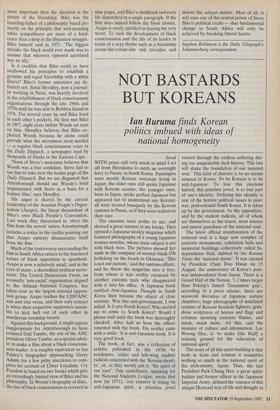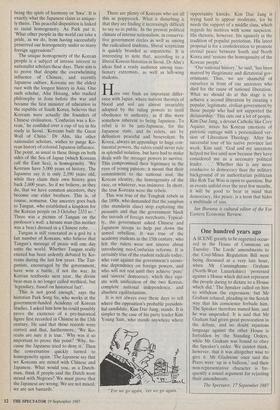NOT BASTARDS BUT KOREANS
Ian Buruma finds Korean
politics imbued with ideas of national homogeneity
Seoul WITH peace still very much in mind I set off from Hiroshima to catch an overnight ferry to Pusan, in South Korea. Passengers were mostly Korean nationals living in Japan; the older ones still spoke Japanese with Korean accents, the younger ones, born in Japan, spoke perfect Japanese but appeared not to understand any Korean; all were treated brusquely by the Korean customs in Pusan, as if they were traitors to their race.
The customs were polite to me, and showed a great interest in my books. They opened a Japanese weekly magazine which featured photographs of a young Japanese woman novelist, whose main subject is sex with black men. The pictures showed her nude in the company of several black GIs frolicking on the beach in Okinawa. 'This is not our custom,' said the customs officer, and he threw the magazine into a tray, from where it was swiftly retrieved by another customs man who disappeared with it into his office. A Japanese book entitled Anti-Japanese Thought in South Korea then became the object of close scrutiny. Was this anti-government, I was asked. Is it pro-North Korea? Who invited me to come to South Korea? Would I please wait until the book was thoroughly checked. After half an hour the officer returned with the book. His verdict came with a smile: 'It is anti-Japanese book. It is very good book.'
The book, in fact, was a collection of articles published in the 1970s by academics, critics and left-wing student radicals concerned with the 'Korean identi- ty', or, as they mostly put it, 'the spirit of our race'. One contributor, speaking for the National Students League, wrote that now (in 1971), 'our country is losing its anti-Japanese spirit, a priceless jewel earned through the endless suffering dur- ing our unspeakably dark history. This loss will shake the foundation of our national soul.' This kind of rhetoric is by no means unusual in Korea. To be Korean is to be anti-Japanese. To lose this precious hatred, this priceless jewel, is to lose part of one's identity. Defining this identity is one of the hottest political issues in post- war, post-colonial South Korea. It is taken up by the government, by the opposition, and by the student radicals, all of whom see themselves as the truest, most sincere and purest guardians of the national soul.
The latest official manifestation of the national soul is a huge new complex of patriotic monuments, exhibition halls and memorial buildings collectively called In- dependence Hall, dubbed by the Korean Times the 'national shrine'. It was opened by President Chun Doo Hwan on 15 August, the anniversary of Korea's post- war independence from Japan. There is a Grand Hall of the Nation, '1.2 times larger than Peking's famed Tienanmen gate', according to a press release; there are waxwork dioramas of Japanese torture chambers; huge photographs of mutilated corpses of Korean freedom fighters; gran- diose sculptures of heroes and flags and columns spouting concrete flames, and much, much more. All this, said the minister of culture and information, Lee Woong Hee, is 'to make [the Hall] a training ground for the education of national spirit'.
The irony of all this spirit-building is that both in form and content it resembles nothing so much as the national spirit of the arch-enemy, Japan. Thus, the late President Park Chung Hee, a great spirit- builder and former officer in the Japanese Imperial Army, defined the 'essence of this unique [Korean] way of life and thought as being the spirit of harmony or 'hwa'. It is exactly what the Japanese claim as unique-
ly theirs. This peaceful disposition is linked to racial homogeneity. As Park put it, 'What other people in the world can take a pride, as we do, from having successfully preserved our homogeneity under so many. foreign aggressions?'
The unique homogeneity of the Korean people is a subject of intense interest to nationalist scholars these days. Their aim is to prove that despite the overwhelming influence of Chinese, and recently Japanese culture, Koreans are the oldest race with the longest history in Asia. One such scholar, Ahn Hosang, who studied philosophy in Jena before the war and became the first minister of education in the republic of South Korea, believes that Koreans were actually the founders of Chinese civilisation. 'Confucius was a Ko- rean,' he confided over a cup of tea in his study in Seoul. 'Koreans built the Great Wall of China.' Dr Ahn, like other nationalist scholars, wishes to purge Ko- rean history of colonial Japanese influence. The point, as usual in these things on both sides of the Sea of Japan (which Koreans call the East Sea), is homogeneity. 'We Koreans have 5,000 years of history. The Japanese say it is only 2,190 years old, while they claim their own history goes back 2,600 years. So if we believe, as they do, that we have common ancestors, they become our elder brothers. This is, of course, nonsense. Our ancestry goes back to Tangun, who established a kingdom for the Korean people on 3 October 2333 BC: There was a picture of Tangun on the professor's wall: a hirsute man (his mother was a bear) dressed in a Chinese robe.
Tangun is still venerated as a god by a fair number of Koreans, who believe that Tangun's message of peace will one day unite the world. Whether Tangun really existed has been ardently debated by Ko- reans during the last few years. The Tan- gunists, encouraged by the government, have won a battle, if not the war. In Korean textbooks next year, the divine bear-man is no longer called mythical, but 'legendary, based on historical fact'.
'This is not good enough,' says the historian Park Song Su, who works at the government-funded Academy of Korean Studies. I asked him how he could possibly prove the existence of a pre-historical figure first recorded in Chinese in the 13th century. He said that those records were correct and that, furthermore, 'We Ko- reans are sure it is true.' Why was it so important to prove this point? 'Why, be- cause the Japanese tried to deny it.' Then the conversation quickly turned to homogeneity again. 'The Japanese say that we Koreans are mixed with Chinese and Japanese. What would you, as a Dutch- man, think if people said the Dutch were mixed with Negroes? We must prove that the Japanese are wrong. We are not mixed, we are not bastards.' There are plenty of Koreans who see all this as poppycock. What is disturbing is that they are finding it increasingly difficult to say so in public. In the present political climate of intense nationalism, in conserva- tive government circles as well as among the radicalised students, liberal scepticism is quickly branded as unpatriotic. It is interesting to note that, according to a liberal Korean historian in Seoul, Dr Ahn's ideas find a ready audience among reac- tionary extremists, as well as left-wing students.
Here one finds an important differ- ence with Japan, where nativist theories of blood and soil are almost invariably adopted by . the ruling powers to instil obedience to authority, as if this were somehow inherent to being Japanese. To rebel is to be anti-Japanese, for the Japanese state, and its rulers, are by definition peaceful and benevolent. In Korea, always an appendage to huge con- tinental powers, the rulers could never rule in splendid isolation, but have had to make deals with the stronger powers to survive. This compromised their legitimacy in the eyes of young patriots; it meant that their commitment to the national soul, the Korean identity, the homogeneity of the race, or whatever, was insincere. In short, the true Koreans were the rebels.
This was true of the Tonghak rebels in the 1890s, who demanded that the yangban (the mandarin class) stop exploiting the peasants and that the government block the inroads of foreign merchants. Typical- ly, the government asked Chinese and Japanese troops to help put down the armed rebellion. It was true of the academy students in the 15th century, who felt the rulers were not sincere about introducing neo-Confucian reforms. It is certainly true of the student radicals today, who rant against the government's econo- mic dependency on foreign powers, and who will not rest until they achieve 'pure' and 'sincere' democracy, which they equ- ate with unification of the two Koreas, complete national independence, and absolute egalitarianism.
It is not always easy these days to tell where the opposition's probable presiden- tial candidate, Kim Dae Jung, stands. It is simpler in the case of his party leader Kim Young Sam, who stands anywhere where
-Ere we go again, 'ere we go again.'
opportunity knocks. Kim Dae Jung is trying hard to appear moderate, for he needs the support of a middle class, which regards his motives with some suspicion. His rhetoric, however, fits squarely in the tradition of populist patriotism. His latest proposal is for a confederation to promote eternal peace between South and North Korea and 'restore the homogeneity of the Korean people'.
'Our national history,' he said, 'has been marred by illegitimate and dictatorial gov- ernments. Thus, we are shameful of ourselves in front of our ancestors who died for the cause of national liberation. What we should do at this stage is to achieve a second liberation by creating a popular, legitimate, civilian government by those people who had not supported the dictatorship.' This cuts out a lot of people. Kim Dae Jung, a devout Catholic like Cory Aquino, mixes his Korean emotions of patriotic outrage with a personalised ver- sion of Liberation Theology. After his successful tour of his native province last week, Kim said, 'God and my ancestors helped me live until now because they have considered me as a necessary political leader. . . .' Whether this is any more conducive to democracy than the military background of an authoritarian politician like Roh Tae Woo is open to question. But as events unfold over the next few months, it will be good to bear in mind that democracy, like peace, is a term that hides a multitude of sins.
Ian Buruma is cultural editor of the Far Eastern Economic Review.



































































 Previous page
Previous page